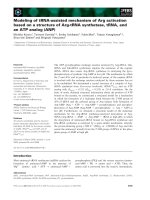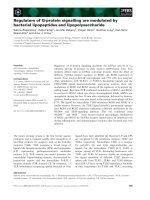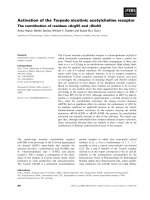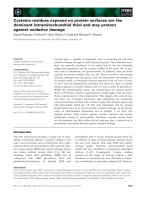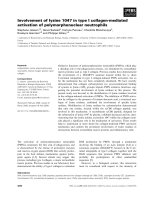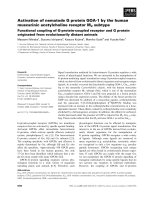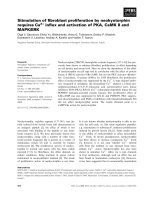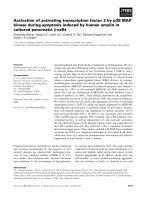Báo cáo khoa học: Activation of nematode G protein GOA-1 by the human muscarinic acetylcholine receptor M2 subtype Functional coupling of G-protein-coupled receptor and G protein originated from evolutionarily distant animals doc
Bạn đang xem bản rút gọn của tài liệu. Xem và tải ngay bản đầy đủ của tài liệu tại đây (577.37 KB, 9 trang )
Activation of nematode G protein GOA-1 by the human
muscarinic acetylcholine receptor M
2
subtype
Functional coupling of G-protein-coupled receptor and G protein
originated from evolutionarily distant animals
Masaomi Minaba
1
, Susumu Ichiyama
2
, Katsura Kojima
3
, Mamiko Ozaki
4
and Yusuke Kato
1
1 Immune Defense Unit, National Institute of Agrobiological Sciences, Ibaraki, Japan
2 Institute for Biomolecular Science, Faculty of Science, Gakushuin University, Tokyo, Japan
3 Silk-Materials Research Unit, National Institute of Agrobiological Sciences, Ibaraki, Japan
4 Department of Biology, Faculty of Science, Kobe University, Japan
G-protein-coupled receptors (GPCRs) are membrane
receptors that are activated by specific agonist binding.
Activated GPCRs affect intracellular heterotrimeric
G proteins, which activate specific effectors (adenylyl
cyclase, phospholipase C, etc.) [1]. The heterotrimeric
G protein consists of Ga,Gb and Gc subunits [2,3].
The coupling specificity with GPCRs and effectors is
mainly determined by Ga, although Gb and Gc also
affect the specificity. Approximately 950 GPCR genes
have been found in the human genome, but only
17 Ga have been identified, which indicates that a sin-
gle Ga must couple with many GPCRs [4,5].
GPCR–G protein signalling regulates various phy-
siological functions in a wide variety of organisms
including plants and animals [6–9]. Therefore, such
physiological functions can be affected by manipula-
tion of the GPCR–G protein signal transduction. Our
interest is in the use of GPCRs derived from evolutio-
narily distant organisms for the manipulation of
G protein signalling. GPCRs recognize a wide variety
of ligands. Although some ligands are conserved in
many organisms (e.g. acetylcholine, serotonin), others
are recognized in only a few organisms (e.g. peculiar
peptide hormones). GPCRs recognizing such unique
ligands are often found in evolutionarily distant organ-
isms. If such GPCRs can couple with the target Ga,
we can manipulate the GPCR–G protein signalling of
transgenic individuals by using specific ligands that do
not activate any receptors in wild-type individuals.
However, the coupling of GPCRs and G proteins
Keywords
biotechnology; Caenorhabditis elegans;
G protein; muscarinic acetylcholine receptor;
nematodes
Correspondence
Y. Kato, Immune Defense Unit, National
Institute of Agrobiological Sciences,
Tsukuba, Ibaraki 305-8634, Japan
Fax ⁄ Tel: +81 29 838 6059
E-mail:
(Received 18 August 2006, revised 12
October 2006, accepted 17 October 2006)
doi:10.1111/j.1742-4658.2006.05542.x
Signal transduction mediated by heterotrimeric G proteins regulates a wide
variety of physiological functions. We are interested in the manipulation of
G-protein-mediating signal transduction using G-protein-coupled receptors,
which are derived from evolutionarily distant organisms and recognize unique
ligands. As a model, we tested the functionally coupling GOA-1, Ga
i ⁄ o
ortho-
log in the nematode Caenorhabditis elegans, with the human muscarinic
acetylcholine receptor M
2
subtype (M
2
), which is one of the mammalian
Ga
i ⁄ o
-coupled receptors. GOA-1 and M
2
were prepared as a fusion protein
using a baculovirus expression system. The affinity of the fusion protein for
GDP was decreased by addition of a muscarinic agonist, carbamylcholine
and the guanosine 5¢-[3-O-thio]triphosphate ([
35
S]GTPcS) binding was
increased with an increase in the carbamylcholine concentrations in a dose-
dependent manner. These effects evoked by carbamylcholine were completely
abolished by a full antagonist, atropine. In addition, the affinity for carbamyl-
choline decreased under the presence of GTP as reported for M
2
–Ga
i ⁄ o
coup-
ling. These results indicate that the M
2
activates GOA-1 as well as G a
i ⁄ o
.
Abbreviations
EC
50
, 50% effective concentration; Ga,Gb and Gc, heterotrimeric G protein alpha, beta and gamma subunits; GPCR, G protein-coupled
receptor; GTPcS, guanosine 5¢-[3-O-thio]triphosphate; IC
50
, 50% inhibitory concentration; M
2
, muscarinic acetylcholine receptor M
2
subtype;
NMS, N-methylscopolamine; QNB,
L-quinuclidinyl benzilate.
5508 FEBS Journal 273 (2006) 5508–5516 ª 2006 The Authors Journal compilation ª 2006 FEBS
derived from evolutionarily distant organisms has not
been systematically examined.
Mammalian Ga of heterotrimeric G protein is categ-
orized into four groups (Ga
s
,Ga
i ⁄ o
,Ga
q ⁄ 11
and Ga
12
)
[10]. Ga
o
is a member of the Ga
i ⁄ o
class. Caenorhabditis
elegans, a nematode, is a genetic model organism widely
used in laboratories [11]. The whole genome sequence of
C. elegans has been determined in multicellular organ-
isms [12]. In the genome of C. elegans,21Ga have been
found [13,14]. Although some Ga appear to be unique
in nematodes, orthologs of mammalian Ga
s
,Ga
q
,Ga
12
and Ga
i ⁄ o
have also been identified. GOA-1 is the Ga
i ⁄ o
ortholog in C. elegans [15]. GOA-1 is specifically
expressed in neurons in adults [16,17]. Knockout and
overexpression of goa-1, the gene encoding GOA-1,
affect some behaviors such as locomotion, egg-laying
and mating [16,17]. In addition, GOA-1 also regulates
the susceptibility to volatile anesthetic [18] and olfactory
adaptation [19]. The function of GOA-1 in neurons is
partly explained as antagonizing EGL-30 (Ga
q
ortho-
log) [20,21]. Furthermore, GOA-1 controls embryonic
spindle positioning in single-cell embryos [22]. In the
embryo, GOA-1 is activated by cytoplasmic guanine
exchange factor-like protein, RIC-8, independently of
GPCR [22]. However, there is no experimental evidence
for GOA-1 activation by GPCRs.
In this study, we tested the functional coupling of the
mammalian Ga
i ⁄ o
-coupled receptor, human M
2
, to the
nematode GOA-1 as a model of manipulation using
GPCRs derived from evolutionarily distant organisms.
The M
2
receptor has been best characterized as a Ga
i ⁄ o
-
coupled receptor since its primary structure determin-
ation in 1986 [23]. Although Gb and Gc are essential for
Ga activation by GPCR [10], GPCR can activate Ga
without Gb and Gc in some GPCR::Ga fusion proteins
[24]. Muscarinic-agonist-dependent Ga activation can
be detected in an M
2
::Ga
i1
fusion protein [25]. A large-
scale preparation of the fusion protein has been estab-
lished using a baculovirus expression system [25].
Therefore, M
2
receptor is one of the best models for
mammalian Ga
i ⁄ o
-coupled receptors. The effector regu-
lated by GOA-1 is still unclear, suggesting that GOA-1
activation should be directly measured to evaluate
the coupling of M
2
with GOA-1. We prepared an
M
2
mutant::GOA-1 fusion protein and directly assessed
the muscarinic-ligand-dependent activation of GOA-1.
Results
Expression of M
2
::GOA-1 fusion protein
The human M
2
receptor is a Ga
i ⁄ o
-coupled receptor.
To test whether M
2
can activate GOA-1, a fusion
protein of M
2
mutant and GOA-1, myc-M
2
(N-D)I3-
del::GOA-1, was expressed in the insect culture cell
Sf21 using a baculovirus expression system (Fig. 1A).
A
B
Fig. 1. Expression of myc-M
2
(N-D)I3del::GOA-1. (A) Diagram of
expression construct. GOA-1 was directly fused at the C-terminus
of M
2
.Amyc-epitope tag was added at the N-terminus of M
2
.To
prevent rapid degradation, the central part of the third intracellular
loop of M
2
was deleted. Asn at putative N-glucosylation sites near
the N-terminus of M
2
were mutated to Asp to avoid various migra-
tions in western blot analyses. (B) Western blot analysis of
myc-M
2
(N-D)I3del::GOA-1. The membrane fraction of baculovirus-
infected cells was studied. The fusion protein was detected using
an alkaline phosphatase conjugated monoclonal antibody against
myc. The calculated mass for the recombinant protein (78 kDa) is
indicated by an arrow. Lane 1, wild-type virus infected cells; lane 2,
recombinant virus infected cells.
M. Minaba et al. Human GPCR activates nematode G protein
FEBS Journal 273 (2006) 5508–5516 ª 2006 The Authors Journal compilation ª 2006 FEBS 5509
In this recombinant protein, GOA-1 was directly fused
at the C-terminus of M
2
.Amyc-epitope tag was added
at the N-terminus of M
2
. To prevent rapid degrad-
ation, the central part of the third intracellular loop of
M
2
was deleted [26]. Asn at putative N-glycosylation
sites near the N-terminus of M
2
was mutated to Asp
to avoid diversified migration in western blot analyses
[27]. These modifications to M
2
do not interfere with
the M
2
–Ga
i ⁄ o
interaction [28]. Membrane fractions of
transfected cells were subjected to western blot analysis
with anti-myc serum (Fig. 1B). A major band (78 kDa)
was detected specifically in transfected cells expressing
the recombinant protein. This is almost identical to the
calculated molecular mass (77 660.17 Da), suggesting
that myc-M
2
(N-D)I3del::GOA-1 was expressed over
the detection sensitivity in the western blot analysis
and well transferred in the membrane fraction.
Binding properties of muscarinic ligands with
M
2
::GOA-1 fusion protein
The binding properties of muscarinic ligands were
examined to reveal whether the M
2
receptor in myc-
M
2
(N-D)I3del::GOA-1 was functional. The membrane
fraction expressing myc-M
2
(N-D)I3del::GOA-1 showed
high-affinity binding to the radiolabeled ligands
l-quinuclidinyl benzilate ([
3
H]QNB) and N-methyl-
scopolamine ([
3
H]NMS) (Fig. 2A). This binding was
abolished by addition of the full antagonist, atropine.
In addition, the 50% inhibitory concentration (IC
50
)
for [
3
H]QNB displacement was estimated for atropine
(5 · 10
)8
m), and the full agonist, carbamylcholine
(5 · 10
)4
m) in the absence of GTP (Fig. 2B). These
IC
50
values are very like those with M
2
(N-D)I3del::
Ga
i1
(5.0 · 10
)8
m for atropine, and 3.3 · 10
)4
m for
carbamylcholine) [25]. These results indicate that M
2
in the GOA-1 fusion protein is functional, and the
ligand-binding properties agree with that of the Ga
i1
fusion protein.
Activation of GOA-1 by muscarinic agonists
Agonist-bound GPCRs are considered to interact with
G proteins. This interaction causes a decrease in the
affinity for GDP of Ga and the subsequent substitu-
tion of GDP by GTP [10]. Such an agonist-dependent
decrease in the affinity for GDP can be detected as the
increase in binding of the nonhydrolysable GTP ana-
log guanosine 5¢-[3-O-thio]triphosphate (GTPcS). This
agonist-dependent decrease of GDP affinity has also
been demonstrated in membrane preparations expres-
sing the M2::Ga
i1
fusion protein [25]. Here, similar
binding properties of GDP and GTPcS were observed
in the membrane preparations expressing myc-M
2
(N-
D)I3del::GOA-1. The binding of GTPcS was
increased by stimulation of myc-M
2
(N-D)I3del::
GOA-1 with carbamylcholine in a dose-dependent
manner (Fig. 3A). The 50% effective concentration
(EC
50
) value was estimated to be 10
)5
m. The increase
of GTPcS binding was completely inhibited by
Fig. 2. Binding of muscarinic ligands. All
experiments were performed in triplicate.
Each data point represents the mean ± SEM.
(A) Binding of [
3
H]QNB and [
3
H]NMS to
myc-M
2
(N-D)I3del::GOA-1. The membrane
fraction containing 10 l g recombinant protein
was tested. (B) Displacement by atropine and
carbamylcholine of [
3
H]QNB binding. The
experiment was performed in the presence
(dotted line) or absence (solid line) of 1 m
M
GTP. [
3
H]QNB binding was normalized to the
value obtained at atropine ¼ 10
)13
M or
carbamylcholine ¼ 10
)7
M, respectively.
Human GPCR activates nematode G protein M. Minaba et al.
5510 FEBS Journal 273 (2006) 5508–5516 ª 2006 The Authors Journal compilation ª 2006 FEBS
atropine (Fig. 3A), suggesting that carbamylcholine
induced the substitution for GTPcS in GOA-1. The
IC
50
value of the displacement of GTPcS by GDP was
3 · 10
)6
m with 0.2 mm atropine, and 10
)4
m without
atropine in the presence of 1 mm carbamylcholine,
which induced the maximum increase in GTPcS bind-
ing (Fig. 3B), suggesting that carbamylcholine caused
the decrease of GDP affinity in GOA-1. These results
indicate that M
2
functionally couples with GOA-1 as
well as Ga
i1
.
GTP affects affinity of muscarinic ligands
The affinity of M
2
for agonists, but not for antago-
nists, decreases on interaction with Ga
i ⁄ o
in the pres-
ence of guanine nucleotides [28–30]. The affinity for
carbamylcholine of myc-M
2
(N-D)I3del::GOA-1 dec-
reased in the presence of GTP (IC
50
¼ 3 · 10
)3
and
5 · 10
)4
m in the presence and absence of GTP,
respectively; Fig. 2B). In contrast, the affinity for atro-
pine was not affected by GTP (Fig. 2A). These results
indicate that M
2
in the fusion protein interacts with
GOA-1 as well as with Ga
i1
in a GTP-sensitive manner.
Discussion
In this study, we have shown that the human Ga
i ⁄ o
-
coupled receptor, M
2
, can activate GOA-1, which is
the Ga
i ⁄ o
ortholog in the nematode C. elegans. The
ligand-binding properties of M
2
mutant::GOA-1 fusion
protein were similar to those of Ga
i ⁄ o
fusion protein.
In addition, GTP causes the decrease of affinity for
carbamylcholine to M
2
. These properties are almost
identical to those of M2–Ga
i ⁄ o
coupling, suggesting
that the function of GOA-1 and Ga
i ⁄ o
was evolutio-
narily conserved in the coupling with M
2
.
These results also indicate that the distinct amino
acids in GOA-1 are neutral for coupling to M
2
.An
alignment of GOA-1 and other M
2
-coupled Ga pro-
teins is shown in Fig. 4. GOA-1 is the ortholog of
mammalian Ga
i ⁄ o
in C. elegans. BLAST database
searches identified the human Ga
o
(accession no.
NM138736) as the most similar Ga in mammals. The
amino acid sequence of GOA-1 is 82.2% identical to
that of Ga
o
. Although the similarity of the aA–aE
region and the region upstream of a4 was relatively
low, the N-terminal region (aN–a1), the aF–aG region
and the C-terminal region (a4–a5) were well conserved
between GOA-1 and Ga
o
[31,32]. The five regions of
the Ga-subunit involved in receptor recognition are
the a2 helix, the b6 ⁄ a5 loop, the a5 helix and the
N- and C- extreme termini [31]. In addition, the a4
helix and a4 ⁄ b6 loop region of Ga
i1
are important for
specific recognition of receptors [33]. The distinct sub-
stitution observed in GOA-1 was relatively rare in
those regions, suggesting that M
2
should interact with
GOA-1 in a similar manner to that of Ga
i ⁄ o
.
The EC
50
value of carbamylcholine for myc-M
2
(N-
D)I3del::GOA-1 in GTPcS binding was estimated to
be 10
)5
m in the presence of 1 lm GDP and 10 mm
MgCl
2
. This value is greater than that of the fusion
protein to Ga
i1
without the N-terminal myc-tag,
M
2
(N-D)I3del::Ga
i1
(2.6 · 10
)7
m), under the same
experimental conditions [25]. The IC
50
values of atro-
pine and carbamylcholine for myc-M
2
(N-D)I3del::
GOA-1 in [
3
H]QNB displacement was like those of
M
2
(N-D)I3del::Ga
i1
. In addition, the myc-tagged M
2
was reported to be indistinguishable from the unmodi-
fied M
2
in [
3
H]QNB binding [34]. These results suggest
Fig. 3. Effect of carbamylcholine and atropine on [
35
S]GTPcS bind-
ing of myc-M
2
(N-D)I3del::GOA-1. All experiments were performed
in triplicate. Each data point represents the mean ± SEM. (A)
Increase in [
35
S]GTPcS binding by carbamylcholine in the presence
of 10
)6
M GDP. M
2
(N-D)I3del alone caused no increase in
[
35
S]GTPcS binding [25]. (B) Decrease in GDP affinity by carbamyl-
choline. The experiment was performed in the presence of 1 m
M
carbamylcholine. Dotted line, in the presence of 0.2 mM atropine;
solid line, in the absence of atropine.
M. Minaba et al. Human GPCR activates nematode G protein
FEBS Journal 273 (2006) 5508–5516 ª 2006 The Authors Journal compilation ª 2006 FEBS 5511
that the addition of myc-tag should not affect the lig-
and-binding properties of M
2
. The mechanism of this
difference in EC
50
values remains to be elucidated.
To date, GOA-1 activation has been reported only
in an RIC-8-dependent and GPCR-independent man-
ner using the GTPcS-binding experiment. Here, we
Fig. 4. Alignment of Ga activated by M
2
. Secondary structures are indicated [32]. The distinct amino acid residues only observed in GOA-1
are represented as inversed characters (gray, distinct but similarity was conserved among all Ga; black, distinct and not similar).
Human GPCR activates nematode G protein M. Minaba et al.
5512 FEBS Journal 273 (2006) 5508–5516 ª 2006 The Authors Journal compilation ª 2006 FEBS
represented the GPCR-dependent GOA-1 activation.
Therefore, both GPCR-dependent and -independent
activation of GOA-1 have been experimentally evi-
denced.
C. elegans is the best genetic model. The generation
of transgenic C. elegans has been established and is
easier than that of other animal models [35]. The
results of this study indicate that the Ga
i ⁄ o
⁄ GOA-1-
coupled receptors may be compatible between
mammals and nematodes. As mentioned previously,
overexpression of GOA-1 causes various visible phe-
notypes in C. elegans, suggesting that further in vivo
studies should be performed using C. elegans towards
the use of GPCRs derived from evolutionarily distant
organisms for manipulation of G-protein signalling.
In this study, M
2
was selected as a model of mamma-
lian Ga
i ⁄ o
-coupled receptors mainly due to its conveni-
ence for experimental use, i.e. the abundant expression
using a baculovirus system has been established, and
the pharmacological properties have been revealed in
detail. Here, we evaluate M
2
for the manipulation of
GOA-1 signalling in C. elegans. The natural ligand of
M
2
, acetylcholine, is a neuro- and neuromuscular trans-
mitter not only in mammals, but also in nematodes
[36], suggesting that the use of M
2
is restricted by the
influence of intrinsic acetylcholine. In C. elegans, three
muscarinic acetylcholine receptors have been found
(GAR-1, -2 and -3). Although the pharmacological
properties of GAR-1 and -2 are clearly distinct from
those of mammals [37,38], that of GAR-3 is compar-
able (e.g. the muscarinic agonist, oxotremorine, is
effective on GAR-3, but not on GAR-1 and -2) [39],
suggesting that the manipulation of GOA-1 signalling
by M
2
using muscarinic agents may be accompanied by
affecting GAR-3 in C. elegans. However, gar-3 is
expressed only in the pharynx and controls pharyngeal
pumping [40], indicating that the side effect of the acti-
vation of GAR-3 is limited. Furthermore, the pheno-
type of gar-3 loss-of-function mutants is almost wild-
type with the exception of a faster pharyngeal pumping
rate [40], suggesting that the side effect of GAR-3 acti-
vation may be avoided using M
2
transgenic worms in a
gar-3 mutant background. In conclusion, M
2
is a good
candidate for the manipulation of GOA-1 signalling in
C. elegans under carefully controlled conditions.
Experimental procedures
Expression of myc-M
2
(N-D)l3del::GOA-1 fusion
protein
The cDNA-encoding M
2
mutant, myc-M
2
(N-D)I3del, was
amplified by PCR using the M
2
(N-D)I3del::Ga
i1
expression
construct, pPAK-M
2
–Ga
i1
[25], as a template with the
following primers: M
2
-myc-EcoRI-s, 5¢-CAGAATTCatg
gagcagaagctgatctccgagga ggacctg ctg
GTGAACAACTCCAC
CAACTCCTCCAACAACTCCCTGGCTCTTACAAGTC
CTTATAAGACA-3¢; HsM2-as, 5¢-TTACCTTGTAGCG
CCTATGTTCTTATAATG-3¢. (An engineered EcoRI
recognition site is single-underlined. The start codon is
double-underlined. The modified original start codon of M
2
is dot-underlined. The engineered region containing myc-
epitope tag encoded region is indicated in lower case.)
GOA-1 cDNA was amplified by RT-PCR using total RNA
separated from mix stage of C. elegans as a template with
the following primers: M2-goa1-s, 5¢-
CATTATAAGA
ACATAGGCGCTACAAGGATGGGTTGTACCATGTC
ACAGGAAG-3¢; M2-goa1-PstI-as, 5¢-CCAATGCATTGG
TT
CTGCAGTTAATACAA GCCGCATCCACGAAGA-3¢.
(An engineered PstI recognition site is single-underlined.
The overlapping region to the C-terminus of M
2
is double-
underlined.) The cDNAs encoding M
2
(N-D)I3del and
GOA-1 were fused by a fusion PCR using the overlapping
region. The fusion cDNA contains a myc-epitope tag (EQ-
KLISEEDL) and an EcoRI recognition site at the 5¢-end
and a PstI recognition site at 3¢-end. The fusion PCR prod-
uct was cloned into a baculovirus transfer vector, pFAST-
Bac1 (Invitrogen, Carlsbad, CA) using the engineered
restriction sites. Recombinant baculoviruses were generated
in Sf21 insect culture cells by using a Bac-to-Bac Baculo-
virus Expression Kit (Invitrogen). The conditioned medium
containing the recombinant viruses was directly used for
the production of recombinant protein. Sf21 cells were
grown at 28 °C to an 80% confluent monolayer and infec-
ted with recombinant viruses. The cells were harvested at
48 h after infection and stored at )80 °C.
Membrane preparation
Frozen myc-M
2
(N-D)I3del::GOA-1 expressed cells were
thawed and homogenized in Sf9 buffer (20 mm
Hepes ⁄ KOH, pH 8.0, 1 mm EDTA, 2 mm MgCl
2
,2mm
EGTA, 1 lm pepstatin, 10 lm leupeptin, 0.28 lm E64,
0.2 mm benzamidine, 0.5 mm phenylmethylsulfonyl fluor-
ide) on ice. The homogenate was centrifuged at 150 000 g
for 1 h. The pellet (membrane fraction) was resuspended
in phosphate buffer (137 mm NaCl, 2.7 mm KCl, 8.1 mm
Na
2
HPO
4
, 1.47 mm KH
2
PO
4
, pH 7.44). Protein concentra-
tion was assessed using a BCA assay kit (Pierce, Rock-
ford, IL) and adjusted at 1 mgÆmL
)1
by adding phosphate
buffer.
Western blot
Five microliters of the membrane fraction was resuspended
in 1· SDS ⁄ PAGE loading buffer. SDS ⁄ PAGE was per-
formed using a 3–15% (w ⁄ v) polyacrylamide gel (ATTO,
Tokyo, Japan). Following electrophoresis, the gel was
M. Minaba et al. Human GPCR activates nematode G protein
FEBS Journal 273 (2006) 5508–5516 ª 2006 The Authors Journal compilation ª 2006 FEBS 5513
washed in Towbin transfer buffer (25 mm Tris ⁄ HCl,
192 mm glycine, 20% methanol, pH 8.3). After soaking the
gel in Towbin transfer buffer containing 0.05% SDS for
15 min to facilitate the transfer efficiency of large mole-
cules, proteins were transferred onto a polyvinylidene fluo-
ride membrane (Immobilon P; Millipore, Billerica, MA)
using a semidry blotting equipment (Trans Blot SD; Bio-
Rad, Hercules, CA). After transfer, the membrane was
incubated in TBS-T buffer (20 mm Tris ⁄ HCl, 140 mm
NaCl, 1% Tween 20, pH 7.5) containing 5% skimmed milk
as a blocking agent for 1 h. The blocked membrane was
incubated with an alkaline phosphatase conjugated mono-
clonal antibody against myc (Invitrogen) for 1 h. Using an
AP conjugate substrate kit (Bio-Rad), myc-tagged recom-
binant proteins were detected as deep violet bands.
Ligand-binding assay
Binding of the radiolabeled muscarinic partial antagonists,
[
3
H]QNB and [
3
H]NMS, was assessed. The membrane
fraction containing 10 lg recombinant protein was added
to 100 lL of the phosphate buffer containing 0.1 nm
[
3
H]QNB or 4 nm [
3
H]NMS in the presence or absence
of 0.2 mm atropine, a full antagonist for muscarinic re-
ceptors. After incubation at 30 °C for 30 min, the reac-
tion was terminated by filtration using a UniFilter-96
(Hewlett Packard, Palo Alto, CA), and rinsed three times
with a KPB buffer (20 mm potassium phosphate, pH 7.0,
0.1 mm NaN
3
) to remove the free labeled compounds.
Scintillation reagent (Microscint20; Hewlett Packard) was
added to each well of the air-dried filter. The radioactiv-
ity of the membrane fraction on the filter was measured
with a scintillation counter (TopCount NXT; Hewlett
Packard).
To estimate the relative affinity of carbamylcholine and
atropine, displacement of [
3
H]QNB binding was estimated.
The membrane fraction containing 10 lg of recombinant
protein was mixed with various concentrations of carba-
mylcholine or atropine in 100 lL of phosphate buffer.
The solution was mixed with 1 nm (final) [
3
H]QNB and
incubated at 30 °C for 30 min. The reaction mixture was
filtered, and the radioactivity was measured as described
previously.
GTPcS-binding assay
The binding reaction was performed in 100 lL of binding
assay buffer (20 mm Hepes ⁄ KOH, pH 8.0, 1 mm EDTA,
160 mm NaCl, and 10 mm MgCl
2
) containing 0.1 nm
[
35
S]GTPcS. Various concentrations of GDP, agonists and
antagonists were added depending on the experimental aim.
After the addition of 10 lg of membrane fraction, the reac-
tion mixture was incubated at 30 °C for 1 h. The reaction
mixture was filtered, and the radioactivity was measured as
described previously.
Computer-assisted sequence analysis
BLAST database searches were performed via http://
www.ncbi.nlm.nih.gov/BLAST/. The molecular mass was
estimated via />Acknowledgements
We are grateful to Professor Tatsuya Haga
(Gakushuin University) for helpful suggestions and
critical reading of this manuscript. This work was
supported by the program for Promotion of Basic
Research Activities for Innovative Biosciences, Japan.
References
1 Wettachureck N & Offermanna S (2005) Mammalian G
proteins and their cell type specific functions. Physiol
Rev 85, 1159–1204.
2 Bourne HR (1997) How receptors talk to trimeric G
proteins. Curr Opin Cell Biol 9, 134–142.
3 Lambright DG, Sondek J, Bohm A, Skiba NP, Hamm
HE & Sigler PB (1996) The 2.0 A
˚
crystal structure of a
heterotrimeric G protein. Nature 379, 311–319.
4 Takeda S, Kadowaki S, Haga T, Takaesu H & Mitaku
S (2002) Identification of G protein-coupled receptor
genes from the human genome sequence. FEBS Lett
520, 97–101.
5 Walker MW, Jones KA, Tamm J, Zhong H, Smith
KE, Gerald C, Vaysse P & Branchek TA (2005) Use
of Caenorhabditis elegans Ga chimeras to detect
G-protein-coupled receptor signals. J Biomol Screen
10, 127–136.
6 Gether U & Kobilka BK (1998) G protein-coupled
receptors. J Biol Chem 273, 17979–17982.
7 Lefkowitz RJ (1989) G protein-coupled receptors. J Biol
Chem 273, 18677–18680.
8 Perfus-Barbeoch L, Jones AM & Assmann SM (2004)
Plant heterotrimeric G protein function: insights from
Arabidopsis and rice mutants. Curr Opin Plant Biol 7,
719–731.
9 Spiegel AM, Shenker A & Weinstein LS (1992) Recep-
tor–effector coupling by G proteins: implications for
normal and abnormal signal transduction. Endocrin Rev
13, 536–565.
10 Simon MI, Strathmann MP & Gautam N (1991) Diver-
sity of G proteins in signal transduction. Science 252,
802–808.
11 Riddle DL, Blumenthal T, Meyer BJ & Priess JR (1997)
C. elegans II. Cold Spring Harbor Laboratory Press,
Cold Spring Harbor, NY.
12 The C. elegans Sequencing Consortium (1998) Genome
sequence of the nematode C. elegans: a platform for
investigating biology. Science 282, 2012–2018.
Human GPCR activates nematode G protein M. Minaba et al.
5514 FEBS Journal 273 (2006) 5508–5516 ª 2006 The Authors Journal compilation ª 2006 FEBS
13 O’Halloran DM, Fitzpatrick DA, McCormack GP,
McInerney JO & Burnell AM (2006) The molecular
phylogeny of a nematode-specific clade of heterotrimeric
G-protein alpha-subunit genes. J Mol Evol 63, 87–94.
14 Jansen G, Thijssen KL, Werner P, van der Horst M,
Hazendonk E & Plasterk RHA (1999) The complete
family of genes encoding G proteins of Caenorhabditis
elegans. Nat Genet 21, 414–419.
15 Lochrie MA, Mendel JE, Sternberg PW & Simon MI
(1991) Homologous and unique G protein alpha sub-
units in the nematode Caenorhabditis elegans. Cell Regul
2, 135–154.
16 Mendel JE, Korswagen HC, Liu KS, Hajdu-Cronin
YM, Simon MI, Plasterk RHA & Sternberg PW (1995)
Participation of the protein Go in multiple aspects of
behavior in C. elegans. Science 267, 1652–1655.
17 Segalat L, Elkes DA & Kaplan JM (1995) Modulation
of serotonin-controlled behaviors by Go in Caenorhabdi-
tis elegans. Science 267, 1648–1651.
18 van Swinderen Metz LB, Shebester LD, Mendel JE,
Sternberg PW & Crowder CM (2001) Goa regulates
volatile anesthetic action in Caenorhabditis elegans.
Genetics 158, 643–655.
19 Matsuki M, Kunitomo H & Iino Y (2006) Goalpha reg-
ulates olfactory adaptation by antagonizing Gqalpha-
DAG signaling in Caenorhabditis elegans. Proc Natl
Acad Sci USA 103, 1112–1117.
20 Miller KG, Emerson MD & Rand JB (1999) Goa and
diacylglycerol kinase negatively regulate the Gqa path-
way in C. elegans. Neuron 24, 323–333.
21 Hajdu-Cronin YM, Chen WJ, Patikglou G, Koelle MR
& Sternberg PW (1999) Antagonism between Goa and
Gqa in Caenorhabditis elegans: the RGS protein EAT-
16 is necessary for Goa signaling and regulate Gqa
activity. Genes Dev 13, 1780–1793.
22 Afshar K, Willard FS, Colombo K, Johnston CA,
McCudden CR, Siderovski DP & Gonczy P (2004)
RIC-8 is required for GPR-1 ⁄ 2-dependent Galpha func-
tion during asymmetric division of C. elegans embryos.
Cell 119, 219–230.
23 Kubo T, Fukuda K, Mikami A, Maeda A, Takahashi
H, Mishina M, Haga T, Haga K, Ichiyama A, Kan-
gawa K et al. (1986) Cloning, sequencing and expression
of complementary DNA encoding the muscarinic acetyl-
choline receptor. Nature 323, 411–416.
24 Seifert R, Wenzel-Seifert K & Kobilka BK (1999)
GPCR–Ga fusion proteins: molecular analysis of recep-
tor–G-protein coupling. Trends Pharmacol Sci 20, 383–
389.
25 Zhang Q, Okamura M, Guo ZD, Niwa S & Haga T
(2004) Effects of partial agonists and Mg
2+
ions on the
interaction of M
2
muscarinic acetylcholine receptor and
G protein Ga
i1
subunit in the M
2
–Ga
i1
fusion protein.
J Biochem 135, 589–596.
26 Ichiyama S, Oka Y, Haga K, Kojima S, Tateishi Y, Shi-
rakawa M & Haga T (2006) The structure of the third
intracellular loop of the muscarinic acetylcholine recep-
tor M
2
subtype. FEBS Lett 580, 23–26.
27 Kameyama K, Haga K, Haga T, Moro O & Sade
´
eW
(1994) Activation of a GTP-binding protein and a GTP-
binding-protein-coupled receptor kinase (beta-adrener-
gic-receptor kinase-1) by a muscarinic receptor m
2
mutant lacking phosphorylation sites. Eur J Biochem
226, 267–276.
28 Hayashi MK & Haga T (1996) Purification and fuc-
tional reconstitution with GTP-binding regulatory
proteins of hexahistidine-tagged muscarinic acetyl-
choline receptors (m
2
subtype). J Biochem 120, 1232–
1238.
29 Ikegaya T, Nishiyama T, Haga T, Ichiyama A, Kobaya-
shi A & Yamazaki N (1990) Interaction of atrial mus-
carinic receptors with three kinds of GTP-binding
proteins. J Mol Cell Cardiol 22, 343–351.
30 Tota MR, Hahler KR & Schimerlik MI (1987) Recon-
stitution of the purified porcine atrial muscarinic acetyl-
choline receptor with purified porcine atrial inhibitory
guanine nucleotide binding protein. Biochemistry 26,
8175–8182.
31 Coleman DE, Berghuis AM, Lee E, Linder ME, Gilman
AG & Sprang SR (1994) Structures of active conforma-
tions of G
ia1
and the mechanism of GTP hydrolysis.
Science 265, 1405–1412.
32 Mody SM, Ho MKC, Joshi SA & Wong YH (2000)
Incorporation of Ga
z
-specific sequence at the carboxyl
terminus increases the promiscuity of Ga
16
toward
G
i
-coupled receptors. Mol Phamacol 57, 13–23.
33 Bae H, Anderson K, Flood LA, Skiba NP, Hamm HE
& Graber SG (1997) Molecular determinants of selectiv-
ity in 5-hydroxytryptamine 1B receptor–G protein inter-
action. J Biol Chem 272, 32071–32077.
34 Park P, Sum CS, Hampson DR, Van Tol HH & Wells
JW (2001) Nature of the oligomers formed by muscari-
nic m
2
acetylcholine receptors in Sf9 cells. Eur J Phar-
macol 421, 11–22.
35 Stinchcomb DT, Shaw JE, Carr SH & Hirsh D (1985)
Extrachromosomal DNA transformation of Caenorhab-
ditis elegans. Mol Cell Biol 5, 3484–3496.
36 Brownlee DJA & Fairweather I (1999) Exploring the
neurotransmitter labyrinth in nematodes. Trends Neu-
rosci 22, 16–24.
37 Lee YS, Park YS, Chang DJ, Hwang JM, Min CK,
Kaang BK & Cho NJ (1999) Cloning and expression of
a G protein-linked acetylcholine receptor from Caenor-
habditis elegans. J Neurochem 72, 58–65.
38 Lee YS, ParkYS, Nam S, Suh S, Lee J, Kaang BK &
Cho NJ (2000) Characterization of GAR-2, a novel G
protein-linked acetylcholine receptor from Caenorhabdi-
tis elegans. J Neurochem 75, 1800–1809.
M. Minaba et al. Human GPCR activates nematode G protein
FEBS Journal 273 (2006) 5508–5516 ª 2006 The Authors Journal compilation ª 2006 FEBS 5515
39 Hwang JM, Chang DJ, Kim US, Lee YS, Park YS,
Kaang BK & Cho NJ (1999) Cloning and functional
characterization of a Caenorhabditis elegans muscarinic
acetylcholine receptor. Recept Channels 6, 415–424.
40 Steger KA & Avery L (2004) The GAR-3 muscarinic
receptor cooperates with calcium signals to regulate
muscle contraction in the Caenorhabditis elegans phar-
ynx. Genetics 167, 633–643.
Human GPCR activates nematode G protein M. Minaba et al.
5516 FEBS Journal 273 (2006) 5508–5516 ª 2006 The Authors Journal compilation ª 2006 FEBS


